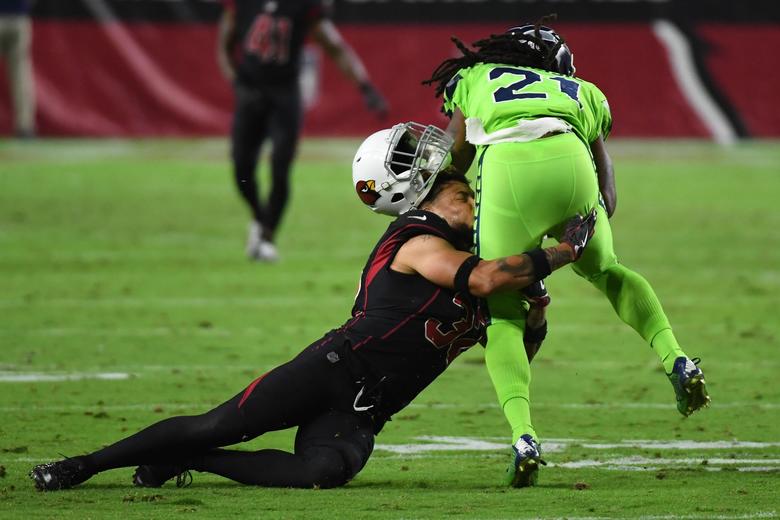Arizona Cardinals safety Tyrann Mathieu either makes a clean tackle or an illegal one. It’s confusing.
Norm Hall/Getty Images
In March, NFL owners approved a slew of new playing regulations. This is something they do every offseason, but there’s an addition to the 2018 rulebook that directly addresses how modern football is played at a foundational level. It pertains to the use of the helmet during tackles, and it has the potential to completely change the league. Or not. It’s confusing.
First, there’s the rule itself:
It is a foul if a player lowers his head to initiate and make contact with his helmet against an opponent. Contact does not have to be to an opponent’s head or neck area – lowering the head and initiating contact to an opponent’s torso, hips, and lower body, is also a foul. Violations of the rule will be easier to see and officiate when they occur in open space – as opposed to close line play – but this rule applies anywhere on the field at any time.
A foul will result in a loss of 15 yards, and the offending player can be tossed depending on three “ejection standards.”
The NFL deserves credit for actually addressing player safety. Last December, Pittsburgh Steelers linebacker Ryan Shazier suffered a serious spinal injury while attempting a tackle against the Cincinnati Bengals. This new rule aims to prevent those types of hits—the kind from which Shazier is still recovering.
While the motivation behind the rule is pure, its implementation will be far from simple. I don’t know if you watched any NFL games last year, but “making contact with the helmet against an opponent” describes roughly every single play. Linemen, for example, engage in that type of action with each snap, as their body-positioning makes it nearly unavoidable. Even the NFL’s own video demonstrating what now constitutes a foul requires multiple slowed-down replays to pinpoint the infractions, lest they be confused with normal football plays.
In July, the league added language to the rule for clarification, but the addendum only works to blur the lines. “This provision does not prohibit incidental contact by the mask or the helmet in the course of a conventional tackle or block on an opponent,” the note reads, without adding any information regarding what constitutes a “conventional” tackle.
There is a very real possibility that this new language will prove to be just that: verbiage, and nothing more. “The challenge with this rule, just like the crown-of-the-helmet rule that went in in 2013, is how can the official at full-speed officiate that consistently?” former NFL head of officiating Dean Blandino told Deadspin’s Dom Cosentino. The new helmet rule replaces that 2013 iteration, but both effectively address the same kinds of plays. In reality, though, the crown-of-the-helmet rule addressed few plays at all. “It wasn’t officiated,” Blandino said. “The game happens so fast.”
On Thursday, the Baltimore Ravens and Chicago Bears played in the first preseason contest of 2018, and three players were flagged for illegal use of the helmet over the course of the game. Ravens safety Bennett Jackson was one of the penalized players, though he insisted that his tackle was “perfect.” Al Michaels and Cris Collinsworth were calling the game for NBC, and they had trouble discerning whether Jackson’s hit was illegal or just a normal football play.
“I feel like they’re trying to harp on it a lot more in preseason, so they’re going to throw flags even on times when it’s not necessarily head to head, just to make people aware of it,” Jackson told reporters after the game. “I spoke to the ref. He even said, ‘Hey, it’s preseason, we got to throw the flag.’”
If anything, the NFL’s well-meaning attempt at a broad fix represents the league acknowledging (in a roundabout manner) that violence is fundamental to the sport. If it wants to truly improve player safety, refs will be instructed to strictly enforce this rule in all instances. This would result in choppy games with tons of penalties and delays. Fans would hate it, as would many players, but the game would be safer. We’ll soon see whether that’s the NFL’s goal, or if the flags are flying just because it’s preseason.
